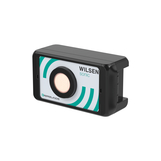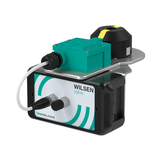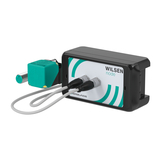Wireless Sensors
Whenever sensor technology is used outside of clearly defined industrial production environments or additional measurement data is to be subsequently queried in existing systems, various challenges and obstacles arise. With its “WILSEN” series of wireless industrial IoT sensors, Pepperl+Fuchs utilizes the globally standardized LoRaWAN® (Long Range Wide Area Network) technology to provide a remedy here. The IP66/67 WILSEN central units are equipped with a powerful lithium battery and wirelessly transmit measurement data securely and energy-efficiently via LoRaWAN to cloud-based IoT platforms for further evaluation.
In addition, the central units also provide GPS information, temperature values, and the battery charge status via LoRaWAN. By combining the central unit with different types of main sensors, a wide range of applications can be covered—including the most remote locations and under the most adverse conditions.
The integration of the wireless IoT sensors into M+O (Monitoring and Optimization) applications is seamless, as sensor data can not only be received, but parameter settings in the WILSEN sensors can also be conveniently made remotely via the "downlink channel". Pepperl+Fuchs provides a free web service for this purpose. Alternatively, the sensors can also be parameterized directly on site via an app for iOS or Android.
As a helpful component for optimizing battery performance, Pepperl+Fuchs offers a free, web-based battery lifetime calculator. This tool allows users to calculate the expected battery life of their WILSEN sensors based on a range of parameters.

Due to an integrated ultrasonic transducer, the WILSEN.sonic.level enables the detection of fill levels over a range of 2.5 m, 4 m, or 7 m. This wireless LoRaWAN sensor solution makes use of all the advantages of the ultrasonic principle: material properties, surface structures and colors as well as snow, fog, or dust do not affect the quality of the measurement results. In addition, the cone-shaped propagation of the sound field makes it possible to monitor a larger measuring area than with a point-based sensing principle. The WILSEN.sonic.level can be adapted to the operating conditions with high precision due to the parameterization of the sound beam, a resolution of 1 mm, adjustable measuring intervals, and a selectable evaluation algorithm. In addition to the distance value in millimeters, the WILSEN.sonic.level also transmits the fill level of a container directly in the form of a percentage value.
Typical Applications
Monitoring fill levels in collection containers, recycling containers, tanks, or silos

The WILSEN.sonic.distance is optimized for distance measurement and covers ranges of 2.5 m, 4 m, or 7 m. Like its sister device WILSEN.sonic.level, this wireless LoRaWAN sensor solution makes use of all the advantages of the ultrasonic principle: material properties, surface structures and colors as well as snow, fog, or dust do not affect the quality of the measurement results. In addition, the cone-shaped propagation of the sound field makes it possible to monitor a larger measuring area than with a point-based sensing principle. The WILSEN.sonic.distance can be adapted to the application conditions with high precision due to the parameterization of the sound beam, a resolution of 1 mm, adjustable measuring intervals, and a selectable evaluation algorithm. Beyond that, this LoRaWAN sensor solution also provides echo amplitude values, supporting alignment of the devices to the water surface. Additionally, this information provides a valuable general feedback on the quality of the received echo signal and therefore its reliability.
Typical Applications
Monitoring of water levels for flood protection, height monitoring of pallets in pallet storage locations, general distance measurement tasks

Specially developed for applications in process technology and water management, the WILSEN.valve LoRaWAN sensor solution is used to detect valve positions. It combines signal reliability with simple operation and high flexibility: different types and variants of energy-optimized and correspondingly battery-saving NAMUR and 2-wire low-power DC sensors, such as inductive single or double sensors, can be connected to the central unit via standardized M12 connections. In addition to the valve status, the WILSEN.valve also transmits diagnostic data and fault states such as short circuits or lead breakages. Pepperl+Fuchs also offers a ready-made mounting solution (in accordance with EN-ISO5211) for adapting the system to most valves and fittings on the market. This includes mounting brackets, adapter plates, and complete mounting sets.
Typical Applications
Valve position feedback and end position monitoring of manual valves and manual lever valves in process plants or water management systems

The WILSEN.node is the universal all-rounder among the LoRa-based M+O sensors from Pepperl+Fuchs and enables the presence of a wide variety of objects to be detected. For this purpose, a wide range of different types of main sensors can be connected to the two M12 connections on the front. These include energy-optimized inductive and capacitive sensors as well as other NAMUR or 2-wire low-power DC sensors of various types (e.g., float switches or vibration limit switches). This makes the WILSEN.node an excellent solution for many types of retrofit scenarios. Like the WILSEN.valve, the WILSEN.node also transmits diagnostic data or fault states such as lead breakage or short circuit in addition to the actual measurement information.
Typical Applications
Monitoring the closing status of manhole covers, transformer houses, barn doors, or pasture gates








 +34 94 4535 020
+34 94 4535 020